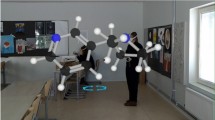Abstract
Materials science is an interdisciplinary field that examines the structure-property relationships in matter for its applications to many areas of science and engineering. Providing a means for intuitive development of understanding of these relationships by young learners and university undergraduates alike is critical. The effectiveness of an immersive low-cost 3D virtual reality (VR) environment was evaluated during a pilot study sponsored by the Center of Integrated Nanomechanical Systems (COINS) program. The 3D VR environment involves the use of a specialized display, sensors, computers, and immersive visual technology equipment. In collaboration with Cognitive Science investigators, our research focused on understanding the impact of the 3D VR environment on the visual ability to perceive structures in three dimensions and on quantifying the learning of COINS participants. The premise was to measure the learning of undergraduate participants in activities designed to evaluate the quality of the learning environment. Our investigation consisted of three stages in which participants learned about carbon nanotubes (CNTs) via traditional methods, physical models and virtual models. Traditional methods (2D projection graphs) were not appealing to participants and did not facilitate depth perception. Physical (ball-and-stick) models motivated participants by allowing interactivity but bond distance/angle measurements were tedious. Virtual models (3D models) offered complete manipulation, real-time measurements and the capability of mimicking realistic atomic forces (attractive/repulsive), giving the user a better insight into the structure of CNTs compared to previous methods. While immersive environments offer virtual models with some of the same benefits of physical models, it is the extended features (e.g. accurate distance representation, computer simulations capability and analysis tools for further investigations) that suggest such environments as effective learning tools for materials science education. Preliminary data analysis suggests that highly accurate perception of a molecular structure is facilitated by the use of immersive environments in which the operator may manipulate and measure important intrinsic information about the structure. Moreover, computer simulations of materials are of great scientific interest for technological progress. We are presently working on the development of the immersive 3D VR environment to perform atomistic simulations to enable scientists to perform accelerated calculations to solve problems with performance enhancements over conventional methods. Another important value in the immersive 3D VR environment lies in its expanded use for multi-disciplinary research, influencing structure-dependent applications, science learning, and design of nanodevices in fields such as materials science, chemistry, engineering, cognitive science, nanotechnology, and computer science among others.
Similar content being viewed by others
References
B. Doblack, L. Dávila and T. Allis, 3D Visualization System: Setup and Installation Manual, UC Merced, 2010.
C. Flores, T. Matlock and L. Dávila, The Effectiveness of Low-Cost 3D Virtual Reality Environments on Nanoscience Learning, presented at the 2010 UC Merced research week conference, Merced, CA, April 13, 2010. Poster recognized with a cognitive science award.
Oliver Kreylos (UC Davis) “Low-Cost VR” 3D VR tutorial pages: http://idav.ucdavis.edu/~okreylos/ResDev/LowCostVR/index.html
T. Huk, Journal of Computer Assisted Learning 22, 392–404 (2006).
J. Wortham, online article, The New York Times, published on November 21, 2010. http://www.nytimes.com/2010/11/22/technology/22hack.html
C.A. Miller, in The Big Ideas of Nanoscale Science and Engineering: A Guidebook for Secondary Teachers, edited by S. Stevens, L. Sutherland and J. Krajcik (NSTA Press, Arlington, Virginia, 2009) p. 173.
Author information
Authors and Affiliations
Corresponding author
Rights and permissions
About this article
Cite this article
Benjamin, N.D., Flores, C., Matlock, T. et al. The Emergence of Immersive Low-Cost 3D Virtual Reality Environments for Interactive Learning in Materials Science and Engineering. MRS Online Proceedings Library 1320, 401 (2011). https://doi.org/10.1557/opl.2011.636
Published:
DOI: https://doi.org/10.1557/opl.2011.636




